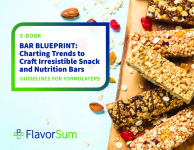Tortilla nutrition benefits from hydrocolloid addition: study
flour to extend the product's shelf life and improve texture while
increasing its nutritional content, say researchers.
According to the Tortilla Industry Association, the tortilla market is the fastest growing segment of the baking industry.
However, innovation is needed to develop tortillas with new nutritional formats, as well as extending their shelf life.
The fortification of bakery goods with flours of peas, beans and chickpeas has proved one way of making the products healthier.
Beans in particular have the potential to lower the glycemic index, which affects blood sugar levels, as well as being high in fibre and protein, and low in fat.
However, when wheat flour is replaced with gluten-free materials, the texture of the bakery good is affected, in turn leading to undesired changes in shelf-life and other sensory products.
Guar gum and sodium carboxymethyl cellulose (CMC) were added to flour tortilla containing 25g per 100g of pinto bean flour to see if this had a positive effect.
The guar gum addition did not affect the acceptability of bean tortillas, but contributed towards a more shelf stable product, indicating its potential for use as an additive in bean tortilla formulations.
"Our results show that there is a market opportunity for introducing new types of tortillas in the North American market, and that fortification of flour tortillas with 25 g/100g of pinto bean flour is feasible and acceptable," wrote the study's authors in the report published in Food Science and Technology .
The study The tortillas were evaluated by 55 participants, who used a hedonic 9-point scale to judge their overall acceptability, flavour, and texture.
The report said: "Hydrocolloid addition caused a significant impact on dough rheology, shelf stability, and some physical properties of pinto bean tortillas."
The bean control showed significantly higher water absorption that the wheat control, and when the hydrocolloids were added, the tortilla's thickness was visibly higher.
However, on its own, CMC led to thinner products, because of its low tolerance to mixing and poor dough structure that does not allow puffiness.
The addition of hydrocolloids also caused a significant change in colour, making brighter tortillas.
The study's authors also said: "While CMC addition resulted in poorer dough tolerance to mixing and decreased shelf stability, guar gum had a positive impact on these parameters.
"However, there have been reports of beneficial effects of combining guar gum and CMC on improving kneading behaviour of tortilla dough and product strength and pliability even after freezing and heating have been reported."
Most importantly for the majority of consumers who consider tortillas should have a longer shelf life than normal bread, guar gum was found to contribute to a more shelf stable product.
The authors concluded: "Although it appears that bean tortillas would appeal to health-conscious consumers, research must be continued in this area for the achievement of adequate formulations for the preparation of high quality products on a large scale."
Source: Food Science and Technology June 2008, DOI: 10.1016/j.lwt.2008.06.005 "Shelf Stability and Sensory Properties of Flour Tortillas Fortified with Pinto Bean (Phaseolus vulgaris L.)
Flour: Effects of Hydrocolloid Addition" Authors: A A Anton, O M Lukow, R G Fulcher, S D Arntfield














